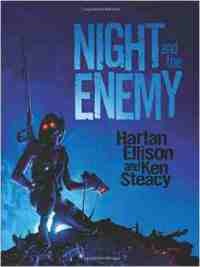
First published in 1987; revised edition published by Dover on November 18, 2015
Over the years, Harlan Ellison wrote several stories about the Earth-Kyba War. Five of those were eventually adapted to graphic format with artist Ken Steacey. A couple appeared, or were slated to appear, in magazines. All five were published as Night and the Enemy in 1987. The Dover edition (2015) adds new introductions by Ellison and Steacey and includes the story “The Few, the Proud” which was not in the original edition.
“Run for the Stars” first appeared in 1957. A drug addict who is forced to run or die at the hands of the Kyben might be Earth’s last best hope of preparing for a Kyben attack. The addict discovers himself as he runs, finds courage he did not know he possessed. As he explains in the introduction, Ellison wrote the original version of this story in his early days, when he was banging out stories as quickly as he could to keep food on the table. That explains why the prose has a first draft quality, but with Ellison it is the gut-punch power of the story that matters.
“Life Hutch” is a vivid account of a man who steers his disabled ship to a planet with a life hutch, only to be attacked and nearly killed by a dysfunctional robot. The story first appeared in 1956. Again, the prose is a little rough but the intensity is pure Ellison. There is almost no dialog in “Life Hutch” so this is more an illustrated story than a graphic adaptation.
“Untouchable Adolescents” (1957) is a “first contact” story with a planet whose inhabitants have already had an unfortunate contact with the Kyben. The kindly humans want to save the alien planet, which is about to crumble apart, but the aliens, having experienced “help” from the Kyben, aren’t interested. “Trojan Hearse” (1956) is a very short story about a Kyben attempt to invade Earth. These are both mildly interesting stories, but weaker than the others in the collection.
“Sleeping Dogs” (1964) is one of the volume’s highlights. Probably influenced by Vietnam, the story concerns the destruction of innocents in blind devotion to a cause. This is a subtler, more nuanced view of the Earth-Kyber war than the earlier stories portray. Not only is it one of the volume’s best stories, it is one of the most successful graphic adaptations of Ellison’s original text.
Another highlight, “The Few, the Proud” (1989), did not appear in the original edition of Night and the Enemy. It is an unillustrated addition to the 2015 edition. The story is basically a monologue, the statement of a man who is about to be sentenced for desertion, after being sold on the glory of military service, only to realize that killers aren’t heroes. No matter the cause for which they kill, no matter how hatefully the enemy is portrayed, they are still nothing more than killers.
This is a volume that Ellison fans will want to acquire, but any fan of graphic storytelling should also enjoy it.
RECOMMENDED